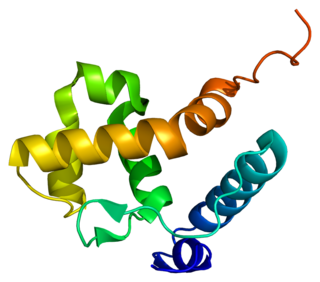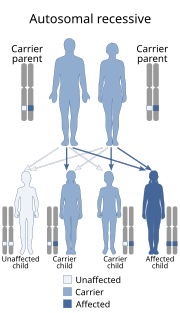
Interferon regulatory factor 6 also known as IRF6 is a protein that in humans is encoded by the IRF6 gene.

XPB is an ATP-dependent DNA helicase in humans that is a part of the TFIIH transcription factor complex.

ERCC2, or XPD is a protein involved in transcription-coupled nucleotide excision repair.

Small nuclear ribonucleoprotein-associated protein N is a protein that in humans is encoded by the SNRPN gene.

AT-rich interactive domain-containing protein 1B is a protein that in humans is encoded by the ARID1B gene. ARID1B is a component of the human SWI/SNF chromatin remodeling complex.

DNA excision repair protein ERCC-8 is a protein that in humans is encoded by the ERCC8 gene.

CAP-Gly domain-containing linker protein 2 is a protein that in humans is encoded by the CLIP2 gene.

Eyes absent homolog 4 is a protein that in humans is encoded by the EYA4 gene.

Bardet-Biedl syndrome 2 protein is a protein that in humans is encoded by the BBS2 gene.

Nucleotide exchange factor SIL1 is a protein that in humans is encoded by the SIL1 gene.

Hermansky–Pudlak syndrome 5 protein is a protein that in humans is encoded by the HPS5 gene.

IQ calmodulin-binding motif-containing protein 1 is a protein that in humans is encoded by the IQCB1 gene.

General transcription factor IIH subunit 5 is a protein that in humans is encoded by the GTF2H5 gene.

T-box transcription factor TBX22 is a protein that in humans is encoded by the TBX22 gene.

Stereocilin is a protein that in humans is encoded by the STRC gene.

Homeobox protein Hox-A2 is a protein that in humans is encoded by the HOXA2 gene.

Zinc finger protein 57 homolog (ZFP57), also known as zinc finger protein 698 (ZNF698), is a protein that in humans is encoded by the ZFP57 gene.

Transmembrane protein 216 is a protein in humans that is encoded by the TMEM216 gene.

ADP-ribosylation factor-like protein 13B (ARL13B), also known as ADP-ribosylation factor-like protein 2-like 1, is a protein that in humans is encoded by the ARL13B gene.






















